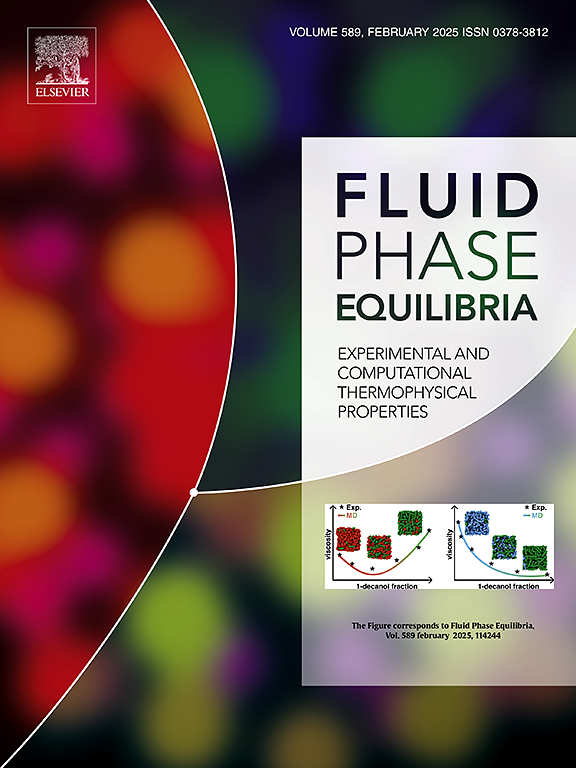临界点附近莫尔斯流体液气共存曲线的微观描述
IF 2.7
3区 工程技术
Q3 CHEMISTRY, PHYSICAL
引用次数: 0
摘要
目前的工作是旨在调查莫尔斯流体的行为在一个细胞模型的框架内的临界点附近。该区域既具有基础意义又具有实际意义,但由于序参量波动的显著影响,对分析提出了挑战。考虑波动的非高斯(四次)分布,提出了一种构造液气共存曲线上半部分并计算其直径的解析方法。对于直线直径表达式中出现的与温度相关的解析项,导出了一个显式表达式。采用以钠为代表的莫尔斯电势参数对相关量进行了数值计算。在计算中加入温度相关项和不加入温度相关项时,分别构建了共存曲线。确定了一个特定条件,在此条件下,所提出的双节点分支与其他研究的蒙特卡罗模拟数据之间的一致性得到了改善,外推到临界点附近。结果表明,在液支计算中加入解析项,在气支计算中省略解析项,可以得到较好的一致性。所提出的分析方法可以为更复杂流体系统中临界现象的理论研究提供有用的见解。本文章由计算机程序翻译,如有差异,请以英文原文为准。
Microscopic description of the liquid–gas coexistence curve for Morse fluids in the immediate vicinity of the critical point
The present work is aimed at investigating the behavior of Morse fluids in the immediate vicinity of the critical point within the framework of a cell model. This region is of both fundamental and practical importance, yet presents analytical challenges due to the significant influence of order parameter fluctuations. An analytical procedure is developed to construct the upper part of the liquid–gas coexistence curve and calculate its diameter, incorporating the non-Gaussian (quartic) distribution of fluctuations. An explicit expression is derived for the temperature-dependent analytical term appearing in the expression for the rectilinear diameter. The numerical evaluation of the relevant quantities is carried out using Morse potential parameters representative of sodium. The coexistence curve is constructed both with and without the inclusion of the analytical temperature-dependent term in the calculation. A specific condition is identified under which the agreement between the presented binodal branches and Monte Carlo simulation data from other study, extrapolated to the immediate vicinity of the critical point, is improved. It is shown that better agreement is achieved when the analytical term is included in the calculation of the liquid branch and omitted in the gas branch. The proposed analytical approach may provide useful insight for the theoretical study of critical phenomena in more complex fluid systems.
求助全文
通过发布文献求助,成功后即可免费获取论文全文。
去求助
来源期刊

Fluid Phase Equilibria
工程技术-工程:化工
CiteScore
5.30
自引率
15.40%
发文量
223
审稿时长
53 days
期刊介绍:
Fluid Phase Equilibria publishes high-quality papers dealing with experimental, theoretical, and applied research related to equilibrium and transport properties of fluids, solids, and interfaces. Subjects of interest include physical/phase and chemical equilibria; equilibrium and nonequilibrium thermophysical properties; fundamental thermodynamic relations; and stability. The systems central to the journal include pure substances and mixtures of organic and inorganic materials, including polymers, biochemicals, and surfactants with sufficient characterization of composition and purity for the results to be reproduced. Alloys are of interest only when thermodynamic studies are included, purely material studies will not be considered. In all cases, authors are expected to provide physical or chemical interpretations of the results.
Experimental research can include measurements under all conditions of temperature, pressure, and composition, including critical and supercritical. Measurements are to be associated with systems and conditions of fundamental or applied interest, and may not be only a collection of routine data, such as physical property or solubility measurements at limited pressures and temperatures close to ambient, or surfactant studies focussed strictly on micellisation or micelle structure. Papers reporting common data must be accompanied by new physical insights and/or contemporary or new theory or techniques.
 求助内容:
求助内容: 应助结果提醒方式:
应助结果提醒方式:


